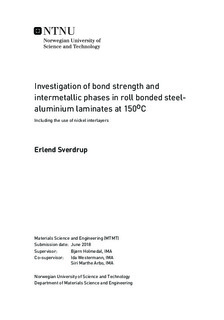Investigation of bond strength and intermetallic phases in roll bonded steel-aluminium laminates at 150oC - Including the use of nickel interlayers
Master thesis
Permanent lenke
http://hdl.handle.net/11250/2576492Utgivelsesdato
2018Metadata
Vis full innførselSamlinger
Sammendrag
This master's thesis investigates intermetallic growth and metallurgical bonding in cold roll-bonded steel-aluminium laminates. Commercially pure AA1080 aluminium alloy have been roll-bonded with two different steel types, namely high-strength low-alloyed (HSLA) steel and stainless steel. The samples went through a pre-rolling procedure consisting of scrubbing in acetone, wire-brushing with a rotating steel-wire brush and heat-treatment in 185oC hot air for 10min. The pre-rolling procedure aimed to clean the surface and create a work-hardened brittle layer. One series also include the use of a high purity nickel interlayer between aluminium and steel. Hardness, degree of deformation and bond-strengths were analysed and evaluated, and the samples were characterised using Light Optical Microscopy (LOM) and Scanning Electron Microscopy (SEM).
In order to study and compare the growth of intermetallic phases along the three different interfaces (Fe-Al, Fe-Ni and Al-Ni), samples cut from the same roll-bonded specimen containing Ni interlayer were heat-treated at different times and temperatures. Intermetallic phases were successfully grown in both Fe-Al and Al-Ni binary systems, and their growth rates were described by a parabolic law. Values for activation energies and pre-exponential coefficients were modelled by a best-fit approach and found in agreement with literature. Characteristic X-rays were analysed in SEM, but intermetallic phases were not successfully quantified. It is suggested that quantification should be carried out with more powerful tools such as Transmission Electron Microscopy (TEM) and X-ray Crystallography.
Both steel types were prone to work-hardening during roll-bonding. Aluminium behaved different depending on which steel type it was roll-bonded with. Aluminium roll-bonded with low-alloyed steel experienced net recovery (both static and dynamic) whereas aluminium roll-bonded with stainless steel experienced no change in hardness (static recovery followed by work hardening).
